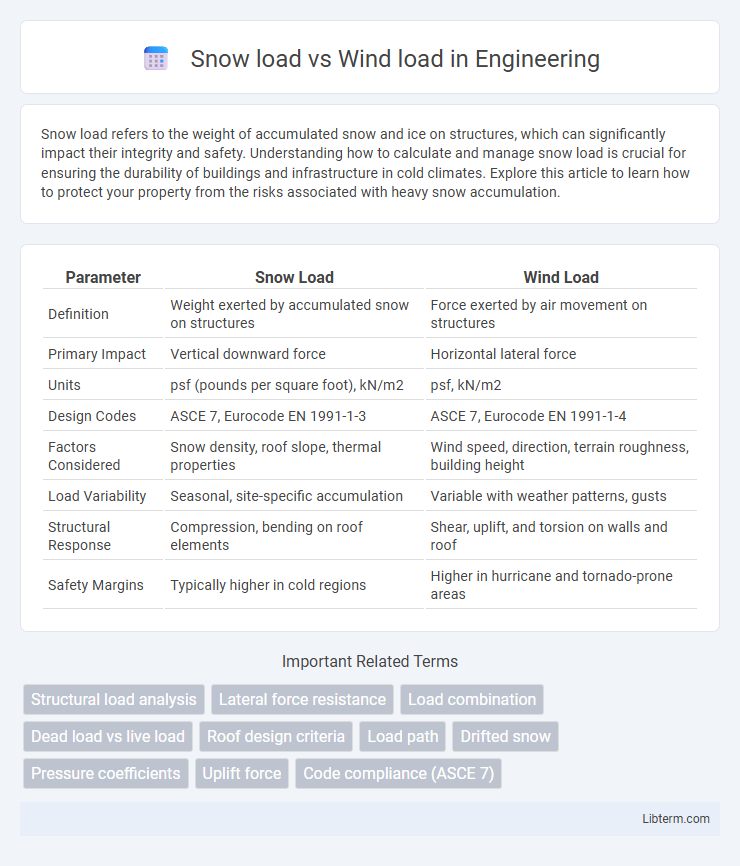Snow load refers to the weight of accumulated snow and ice on structures, which can significantly impact their integrity and safety. Understanding how to calculate and manage snow load is crucial for ensuring the durability of buildings and infrastructure in cold climates. Explore this article to learn how to protect your property from the risks associated with heavy snow accumulation.
Table of Comparison
| Parameter | Snow Load | Wind Load |
|---|---|---|
| Definition | Weight exerted by accumulated snow on structures | Force exerted by air movement on structures |
| Primary Impact | Vertical downward force | Horizontal lateral force |
| Units | psf (pounds per square foot), kN/m2 | psf, kN/m2 |
| Design Codes | ASCE 7, Eurocode EN 1991-1-3 | ASCE 7, Eurocode EN 1991-1-4 |
| Factors Considered | Snow density, roof slope, thermal properties | Wind speed, direction, terrain roughness, building height |
| Load Variability | Seasonal, site-specific accumulation | Variable with weather patterns, gusts |
| Structural Response | Compression, bending on roof elements | Shear, uplift, and torsion on walls and roof |
| Safety Margins | Typically higher in cold regions | Higher in hurricane and tornado-prone areas |
Understanding Snow Load: Key Factors
Snow load depends on factors such as snow density, depth, and moisture content, which directly impact the weight exerted on structures. Geographic location and roof shape influence snow accumulation and potential drifting, affecting load distribution. Accurate assessment of these variables is crucial for structural safety and compliance with building codes.
Defining Wind Load: Essential Elements
Wind load refers to the force exerted by air movement on structures, quantified by factors such as wind speed, direction, and duration. Essential elements include dynamic pressure, exposure category, building height, and shape, which collectively influence the design load calculations. Accurate assessment of wind load ensures structural stability and safety against lateral forces caused by varying wind conditions.
Differences Between Snow Load and Wind Load
Snow load refers to the weight of accumulated snow on structures, primarily influenced by snowfall depth, density, and roof shape, while wind load results from the pressure exerted by wind speed and direction on building surfaces. Snow load is a static, vertical force concentrated on roofs, whereas wind load applies dynamic, lateral forces to walls and roofs, affecting structural stability differently. Design codes account for these differences by specifying unique load factors and distribution methods for snow and wind to ensure safety and durability in various climates.
Building Codes and Load Requirements
Building codes specify distinct requirements for snow load and wind load to ensure structural safety under varying environmental conditions. Snow load regulations are based on geographic climate zones and roof characteristics, with standards such as ASCE 7 providing minimum ground snow load values for different regions. Wind load requirements consider factors like building height, exposure category, and wind speed maps, mandating specific design pressures as outlined in codes like the International Building Code (IBC) and ASCE 7 to resist uplift and lateral forces.
Climate Impact on Structural Loads
Snow load and wind load vary significantly based on regional climate conditions, directly influencing structural design requirements. In colder climates with heavy snowfall, snow loads exert vertical pressure on roofs, necessitating stronger support systems, while in coastal or storm-prone regions, wind loads impose lateral forces that demand robust anchoring and bracing. Accurate climate data integration into building codes ensures structures withstand specific environmental stresses, reducing risk of failure and enhancing safety.
Materials and Design Considerations
Snow load requires materials with high compressive strength and durability to withstand prolonged weight accumulation, often leading to reinforced roofing structures using steel or engineered wood. Wind load demands flexible, aerodynamic designs and materials like resilient aluminum or treated timber that resist uplift and lateral forces through secure anchoring and bracing. Effective structural engineering balances both loads by integrating load-specific characteristics, such as snow load bearing capacity and wind-resistant fasteners, ensuring safety and longevity in varying climates.
Common Failures: Snow Load vs Wind Load
Common failures in structures due to snow load include roof collapses caused by excessive accumulated weight exceeding design limits, leading to compromised structural integrity and potential collapse. Wind load failures often involve lateral force resistance issues, such as inadequate anchoring and bracing, resulting in structural deformation, uplift, or failure of roofing elements and cladding. Proper engineering design must address both snow and wind loads by considering regional climatic data, material strengths, and load combinations to prevent catastrophic failures.
Testing and Measurement Methods
Snow load testing relies on static load simulators and strain gauges to measure structure deformation under accumulated weight, while wind load testing employs wind tunnels and pressure sensors to replicate dynamic forces and assess pressure distribution. Both methods utilize finite element analysis (FEA) for predictive modeling, enhancing accuracy in safety evaluations. Instrumentation like load cells and anemometers are critical for precise measurement in both snow and wind load assessments.
Mitigation Strategies for Both Loads
Mitigation strategies for snow load include designing roofs with steep slopes, using materials with high load-bearing capacity, and ensuring regular snow removal to prevent accumulation. Wind load mitigation involves reinforcing structural elements, installing wind-resistant cladding, and using aerodynamic building shapes to reduce pressure impact. Combining these approaches enhances overall building resilience against both snow and wind loads effectively.
Future Trends in Load-Resistant Building Design
Future trends in load-resistant building design emphasize integrating advanced computational models to predict snow load and wind load impacts more accurately, enabling optimized structural resilience. Innovations in materials such as high-strength composites and adaptive facades enhance buildings' capacity to withstand extreme weather conditions while reducing overall weight. Emphasis on sustainability drives the development of smart, responsive systems that adjust to real-time environmental load variations, promoting safety and efficiency.
Snow load Infographic

 libterm.com
libterm.com